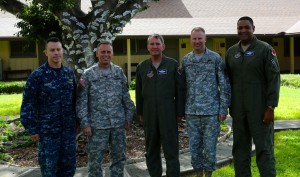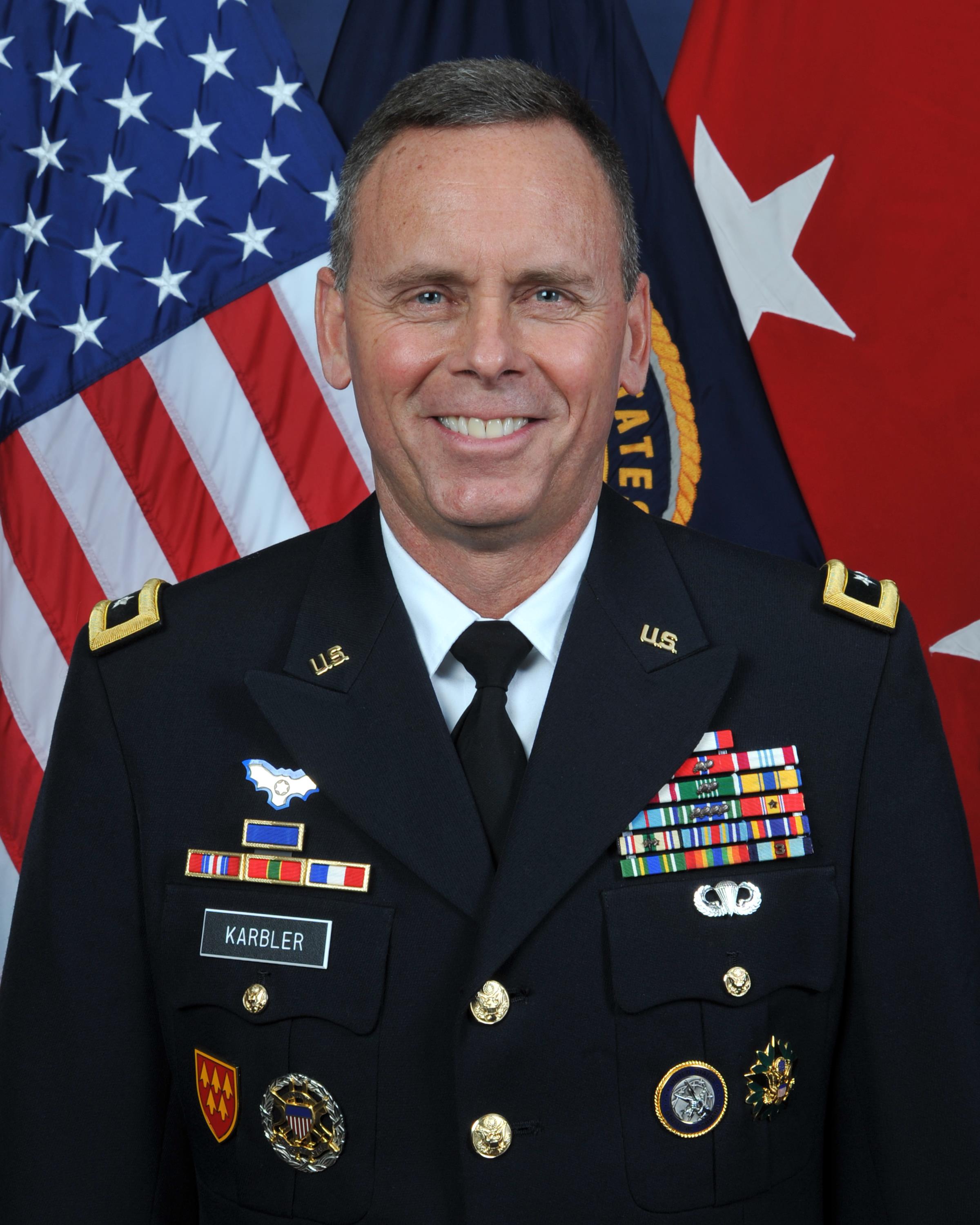Brigadier General Karbler on the Role of Missile Defense In the Pacific, 2014
During a visit to PACOM in late February 2014, I had a chance tointerview the Commanding General of the 94th Army Air and Missile Defense Command located at Fort Shafter near Honolulu, Brig. Gen. Daniel Karbler.
Notably, if you look at his background you see that he learned his trade under fire in the Middle East, having deployed to Israel in 1991 as part of Task Force Patriot Defender in support of Desert Storm and deployed to Riyadh, Saudi Arabia in support of Operations Desert Thunder II and Desert Fox.
Talking with the General and his team was not simply a Washington-based seminar of possibilities but of combat realities and shaping the joint way ahead.

The 94th has theater-wide responsibility for an ADA Brigade, 3 PATRIOT Battalions, 1 THAAD Battery on Guam, and currently one mobile radar detachment (the AN/TPY2 Radar) in Japan with an additional radar coming soon to Japan as well based on an announced agreement last Fall.
This function is the 21t century version of the old Air Defense Artillery role for the US Army, and unlike the significant questioning of the future of the Army after Iraq and Afghanistan, this part of the Army is in high demand from the joint forces and has no need to question its role and significance in the Pacific (or of their compatriots in the Middle East for that matter).
The first deployment of THAAD to the region last year marks an important turning point in the role of Army ADA in the Pacific and is a harbinger for things to come.
The interview held with the 94th Commanding General clearly reinforced the role of ADA in the joint mission.
The meeting was held in the HQ building which is an old school house which belies the significance of the command and its impact in the Pacific. Brig. Gen. Daniel Karbler commented that “my office is probably the former principal’s office.”
Underscoring the joint nature of the mission and its strategic trajectory to shape a combat grid which is increasingly designed to enable distributed operations, the interview with the General was a roundtable with key USN, and USAF present who discussed the cross synergy role of missile defense and its role in Pacific defense.
A key theme was simply that deploying THAAD on Guam had freed up the Aegis to be deployed more effectively in its multi-mission maritime role.
The impact of THAAD and PATRIOT to free up the Aegis is a significant contribution to Air-Sea battle.
The General explained that the networking or cross linking of THAAD, Patriot and various radars under his control with NAVY assets was creating a crucial synergy central for evolving 21stcentury capabilities.
Currently, the ADA branch represents only 1.6% of the Army’s force structure. But the Army Chief of Staff has emphasized its significant and growing role in the future.
With the coming of a second BMD radar to Japan (as agreed last Fall), the mobile radar system used by THAAD will have more sensors available to empower the force.
And doing a better job of linking in Patriots to the system helps as well.
The General discussed the role of ADA within Pacific defense as part of the support to airpower and to strategic decision making.
He emphasized that the capabilities of ADA helped provide time to determine how to both generate more air power and how to use airpower and provided the national command authority time to determine how best to respond to a crisis.
There are three ways to deal with an incoming missile defense.
There is passive defense, but there is only so much hardening and dispersal one can do without degrading your combat capability, and their many soft targets which cannot be hardened.
You can use air strikes to take out the adversary’s missile strike force, but you may not wish to do that right away or have not fully mobilized your capability.
The role of having active defense or an interceptor force is to buy time for [Lieutenant] General [Jan-Marc] Jouas (7thUSAF Commander in the Pacific) or General [Hawk] Carlisle (the PACAF Commander) to more effectively determine how to use their airpower.
It also allows the National Command Authority to determine the most effective way ahead with an adversary willing to strike US or allied forces and territory with missiles.
Air Force Col. Mark Harysch from PACAF Strategy and Plans sees the Army’s ADA role is a central part of the evolution of the joint force.
The way the Pacific Air Force strategist sees it is that the joint force is working hard on cross domain synergy and cross linking assets.
The objective is to have the relevant platform to a mission able to draw on deployed sensors within the grid to execute the most effective approach for mission execution.
General Hostage (the ACC Commander) has spoken of the combat cloud.
That is what we are building here in the Pacific.
For example, the contribution of the F-22 may not be in the air-to-air domain but to provide the best sensor available to the relevant task in a mission.
The F-35 will add significant new capabilities to the layered approach as well.
In other words, the sense around the table among the U.S. Army, Air Force and Navy personnel that the way ahead BEING built today is cross domain collaborative operations.
The THAAD system as well can support evolving Pacific defense in another sense.
As Col. Robert Lyons, the 94thAAMDC Chief of Staff noted,
The THAAD radar and interceptors can be deployed separately. We can put the radar in one location and deploy launchers to 3 launchers in another and 2 to 3 launchers in yet another and provide capability to operate over a geographic operational area. Given the geography of the Pacific thinking along these lines will give us options and enhance deterrence.
Lyons also underscored that the working relationship with allies over time is yielding enhanced combat capability.
We deployed Patriot on Okinawa in 2006 and it operated initially pretty much as a standalone system. Now we are working much more effectively with the Japanese Patriots to provide much greater potential integration. As Gen Karbler often says, you can’t [Request for Forces] Trust, and you can’t Surge Relationships.
Clearly, one key way ahead is to combine the evolving US approach to distributed operations with allied enhancement of their own capabilities to shape a new collaborative Pacific defense system.
The Army ADA evolution is clearly a central contributor to the kind of defense capability which the US needs in the Pacific and which enables credible and effective collaboration with US allies on the path to enhance their own capabilities.
One can learn a lot by visiting the principal’s office at the 94thAAMDC.
I certainly did.
Note: Since the time of our interview, now Major General Karbler has become Chief of Staff at the US Strategic Command.
Major General Daniel L. Karbler is the Chief of Staff, U.S. Strategic Command (USSTRATCOM), Offutt Air Force Base, Nebraska.
He is the principal advisor to the USSTRATCOM commander and deputy commander, and directs the activities of the command staff by developing and implementing policies and procedures in support of the command’s missions. He chairs numerous boards, oversees the command’s corporate process and serves as the director of the commander’s staff.
Maj. Gen. Karblermost recently served as the Commanding General of the U.S. Army Test and Evaluation Command. Prior to that, he served as the Director, Joint and Integration, Army G-8 at the Pentagon.
Since his commissioning, Maj. Gen. Karbler has held multiple leadership positions, from platoon leader to installation chief of staff and school commandant.
He has commanded both B Battery and D Battery in the 5th Battalion, 7th Air Defense Artillery Regiment, 32nd Army Air and Missile Defense Command (AAMDC) while assigned to U.S. Army Europe. Maj. Gen. Karbler also commanded 3rd Battalion, 43rd Air Defense Artillery Regiment, 32nd AAMDC at Fort Bliss, Texas; the 31st Air Defense Artillery Brigade, 32nd AAMDC at Fort Sill, Oklahoma; and the 94th AAMDC at Fort Shafter, Hawaii.
Maj. Gen. Karbler earned his Bachelor of Science degree in 1987 from the United States Military Academy at West Point where he was commissioned as a second lieutenant in the Air Defense Artillery branch. His military education includes the Air Defense Artillery Officer Basic and Advanced Courses, the Command and General Staff College and the National War College.
His awards include the Distinguished Service Medal, Legion of Merit, Bronze Star, Defense Meritorious Service Medal, and the Israeli Air Force Combat Operations Badge.

